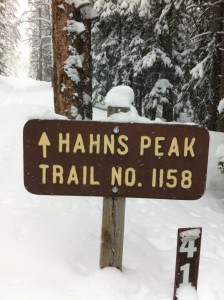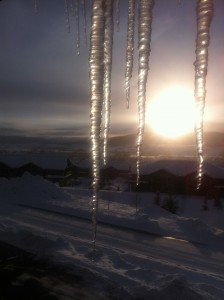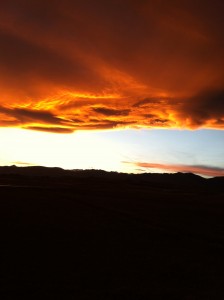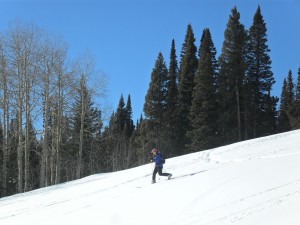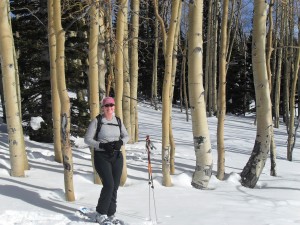Kundalini

The Chakras
Now throughout your life, God, or your higher self has been dishing out these little bits of guidance to you, and depending on what you do with it will dictate whether or not you get any more. God will keep handing out those doses of enlightenment until you use them the wrong way, or even if you don’t use them at all. God wants to see what you can do with it, God wants to see what your true potential is, and who really knows as a society what our true potential is, we sure as hell don’t. – Winston Branko Churchill
Winston understood the gift, what did he do with his enlightenment?
Kundalini is a powerful psychological energy. It has been recognized for a long time. The Hindus described it long before Christ was born and so is now recognized as spiritual phenomenon. It is described as a potential energy coiled at the base of your spine like a snake, a personal power laying dormant, waiting for the right conditions to be released. Carl Jung understood the relationship between Kundalini and western understanding of psychology. The effect on humans is real.
In Hindu understanding, to reach its full potential your Kundalini energy must rise through your spine up to your head. This can only happen if your 7 chakras have been opened. Then you experience a great understanding and connection with the universe. In Eastern interpretation, Kundalini is what gives rise to genius, to great wisdom and understanding, to absolute contentment.
To achieve this involves extensive training. It takes years of study and meditation under a guide, or guru. However, in rare individuals it can happen spontaneously, a great and dangerous power poured into a psyche unexpectedly. An unprepared mind can be greatly disturbed by this surge of energy. A Kundalini Awakening can be a gift from God or a curse from the Devil.
During a particularly intense meditation exercise Winston experienced a strange and profound transition in awareness. Later he became convinced that he had experienced a Kundalini Awakening. At the time it was unexpected and unprecedented, he had no idea what had happened to him or how to cope with it. But his life had changed forever. His awakening had given rise to the demons.
Posted in 40 Demons Archive by Mark with comments disabled.
Steamboat in Feburary

Fireworks on Howelsen Hill, Steamboat Springs
We went up to Steamboat again last weekend and were surprised to find the town celebrating the 100th anniversary of their Winter Carnival. The town was packed with people for events that included the firework show seen above. It looked like fun but every time we go up there we spend as much time as we can in the mountains so we didn’t see much of the Carnival. As a matter of fact, when the fireworks started on Saturday we took advantage of the emptying restaurants to get seats without a wait. As soon as the fireworks were over the place was packed.
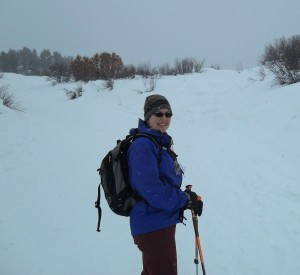 Anyway, we found a lot of new snow and excellent backcountry conditions. All the northern mountains appeared to get a good amount this weekend but Steamboat got a dump of 10 inches on Saturday and even more on Sunday. We went up Emerald Peak, located just west of downtown, on Saturday. It was gray and breezy most of the day but this was good because with that gloomy sounding weather comes the snow. The trail up Emerald is groomed for about 2 miles. The snow is solid enough to walk on, and people do hike up this trail without snowshoes or skis, which I don’t quite understand, but there it is. It’s also a popular place to bring dogs.
Anyway, we found a lot of new snow and excellent backcountry conditions. All the northern mountains appeared to get a good amount this weekend but Steamboat got a dump of 10 inches on Saturday and even more on Sunday. We went up Emerald Peak, located just west of downtown, on Saturday. It was gray and breezy most of the day but this was good because with that gloomy sounding weather comes the snow. The trail up Emerald is groomed for about 2 miles. The snow is solid enough to walk on, and people do hike up this trail without snowshoes or skis, which I don’t quite understand, but there it is. It’s also a popular place to bring dogs.
As you climb up the hill you see this huge open field to your right. Apparently this area was  cleared for farming many decades ago but is now just a large open slope. Steamboat bought the property a couple years ago with help from the Colorado Lottery funds and is now turning it into a recreation area, Nordic skiing in winter and mountain biking in summer. We skied this field a couple of times but today we were sticking to the main track up the hill.
cleared for farming many decades ago but is now just a large open slope. Steamboat bought the property a couple years ago with help from the Colorado Lottery funds and is now turning it into a recreation area, Nordic skiing in winter and mountain biking in summer. We skied this field a couple of times but today we were sticking to the main track up the hill.
The groomed track ends at an overlook at the two mile mark. On a clear day you get a view of the beautiful Yampa valley, but not on Saturday. We were in the clouds and so continued on the non-groomed trail another half mile to the summit. Right on top there are several radio towers visible from all over the valley. It was too windy for a break there so we hung out in the trees and enjoyed our hot drinks before our long descent.
The conditions were excellent for the downhill, Shelly remarked that it was the easiest ski down she’s ever done on that track. Usually you have to work your legs hard all the way down to keep under control but this time it was very easy.
On Sunday we drove up to Columbine, a little village of cabins north of Steamboat. Lots of snow there, like ten feet. They seem to be in a little geographic area that just tends to catch the snow. In the past a big group of us would rent out several of these cabins over the long Thanksgiving weekend hoping to ski some early season snow. We reasoned that if there was skiable snow in November, it would be either here or at Wolf Creek pass. It’s a cool little place where you can ski right out your door into the vast wilderness beyond.
 The cabins allow parking for cross country skiers, a good thing because their was so much snow the sides of the road were plowed up walls 5 feet high and there was no way to park there. Hahn’s Peak is an 11,500 foot mountain just east of the cabins and that was our destination. The first part of the route was packed down by snowmobile tracks which eventually ended. We then broke trail for a while. It was snowing on us all the way and very cold, around 20 degrees. The route goes all the way to the summit of Hahn’s Peak giving you a fantastic view (on a clear day). I describe this ski plus another one near the Columbine cabins in my Insolent Guide. The area is a reasonable drive from the front range cities and has the best snow in the state.
The cabins allow parking for cross country skiers, a good thing because their was so much snow the sides of the road were plowed up walls 5 feet high and there was no way to park there. Hahn’s Peak is an 11,500 foot mountain just east of the cabins and that was our destination. The first part of the route was packed down by snowmobile tracks which eventually ended. We then broke trail for a while. It was snowing on us all the way and very cold, around 20 degrees. The route goes all the way to the summit of Hahn’s Peak giving you a fantastic view (on a clear day). I describe this ski plus another one near the Columbine cabins in my Insolent Guide. The area is a reasonable drive from the front range cities and has the best snow in the state.
The snow was kind of funky on Sunday making the ascent a bit more difficult. Added to the cold and trail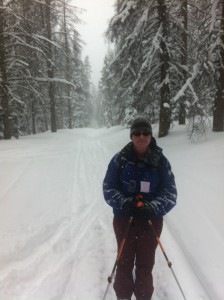 breaking, we decided to turn around after about two hours. And because it was so cold, we got going downhill right away without a rest. It was a good glide down, we got a few turns in fresh powder slopes through a grove of aspen. Back to the car and the drive back to Steamboat.
breaking, we decided to turn around after about two hours. And because it was so cold, we got going downhill right away without a rest. It was a good glide down, we got a few turns in fresh powder slopes through a grove of aspen. Back to the car and the drive back to Steamboat.
On this trip we didn’t get to Strawberry hot springs but did of course get in the hot tub at our place. It’s great to soak in the hot water and drink a Coors Lite while it snows on you. To be clear, I had a Coors Lite, Shelly had some wine. I would never accuse someone other than myself of drinking such a beer even if I had photographic evidence to the contrary.
We watched the sun go down but not before I caught the scene of the sun through icicles from our room balcony. The end of another great weekend in Steamboat!
Posted in Trip Reports by Mark with comments disabled.
Journal
Sunset over Rocky Mountain National Park yesterday
An update to Monday’s post, it looks like Troy Green, the man missing in Rocky Mountain National Park has been found.
The body was found yesterday by snowshoers in an area that “…had been searched several times by ground personnel, a dog team, and helicopter over-flights.” You may ask yourself how a couple of people simply out on a hike could find Troy when a large, coordinated mult-day search involving people, dogs and helicopters could not.
Well, the reasons are complex and this kind of thing happens more often than you would think. A major contributing factor is the vast size of the wilderness and all the obstructions it contains: A typical search might take place in a hundred square mile area of forests, boulders, cliffs and streams. If the subject is not in a high probability area such as a the trail or summit, and is unresponsive, it can be like searching for a needle in a haystack.
I write extensively about the reasons someone can seemingly vanish off the face of the earth in Colorado 14er Disasters, including the details of another extensive search in RMNP for a missing ranger named Jeff Christensen in 2005.
Posted in Journal by Mark with 1 comment.
An Astonishing Vision Quest
This isn’t a camping trip, it’s a shootout with the Devil. I didn’t come here to build campfires and look at the stars, I came out here to track something down, to kill them, one by one, forty days, forty demons.
-Winston Branko Churchill
This is the true story of a man who abandoned a successful business and wrote a 500-page manifesto, became absorbed in Eastern mysticism, exotic hallucinogenic drugs, day-long meditation sessions, and 10 hour mountain bike marathons. He was temporarily committed to a mental hospital before setting off on a 400 mile solo wilderness trek where he experienced increasingly strange visions that lead to his intentional starvation in a tent, alone at 11,000 feet in the San Juan mountains. It was near where members of the Alfred Packer party committed murder and cannibalism in the late 1800s, and close to the location of the Summitville Mine disaster, an irresponsible, man-made environmental catastrophe. This disaster is an important connection. Winston revered the wilderness and this was a great sin against the holy land.
I found out these facts after being drawn to what was already, in late summer of 2008, an intriguing story. Winston had disappeared somewhere in western Colorado and his family and friends were desperate to find him. When people disappear in that manner they’re usually gone for good. It appeared hopeless.
I learned in retrospect that, at the time, Winston was still alive and would remain that way for many more weeks before dying of starvation. His death wasn’t the result of being trapped or disabled in the wilderness, he intentionally starved himself to death. Why would one do that?
As I delved deeper into Winston and the final year of his life, it was revealed to me what his friends and family already knew: He was one of the most interesting, strange, intelligent, wild and intense people I had ever known and his story needed to be told. The strange events that drove him and the reason for his intentional death is told in Forty Demons.
Posted in 40 Demons Archive by Mark with comments disabled.
Journal: Avalanche Hell Weekend

Winter Scene in RMNP by Wayne Boland
There was an impressive amount of reported avalanche activity last weekend here in Colorado, including several injuries and one death. I was out in the mountains but gladly avoided this hazard which I’ll talk about below. Instead, I spent the entire day Saturday in Rocky Mountain National Park snowshoeing near where someone went missing. We were in luck on Saturday as the weather was windy but otherwise crystal clear.
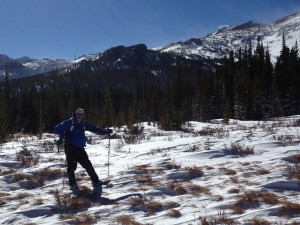 The prevailing wind in the Park is from the west or northwest. Check out the striations in the snow of the photo on the right showing the wind direction. This is an open meadow where the wind scours the ground leaving only a thin, hard-packed layer of snow for most of the season I would guess. This was relatively easy to walk on. However, most of the area is covered in a thick pine forest that catches and holds the wind-blown snow and in many places is 5 to 10 feet thick. Snow is usually not very consolidated this time of year, so walking in the forest even with “floatation,” meaning snowshoes or skis, is still quite difficult. You still sink into the deep snow about a foot or so and basically dig a trench as you break trail. If you have a group of people, the wise thing to do is trade off trail breaking duty often so no single person becomes exhausted.
The prevailing wind in the Park is from the west or northwest. Check out the striations in the snow of the photo on the right showing the wind direction. This is an open meadow where the wind scours the ground leaving only a thin, hard-packed layer of snow for most of the season I would guess. This was relatively easy to walk on. However, most of the area is covered in a thick pine forest that catches and holds the wind-blown snow and in many places is 5 to 10 feet thick. Snow is usually not very consolidated this time of year, so walking in the forest even with “floatation,” meaning snowshoes or skis, is still quite difficult. You still sink into the deep snow about a foot or so and basically dig a trench as you break trail. If you have a group of people, the wise thing to do is trade off trail breaking duty often so no single person becomes exhausted.
My original plan for last weekend was to do the Commando Run, a backcountry ski tour that runs from Vail Pass to Vail. This tour is great fun with beautiful views of the Gore and Sawatch mountains. We’ve done this trip many times, usually on Superbowl weekend to avoid the horrific traffic on I-70. If you’re interested, you can read more details about the Commando in The Insolent Guide. We cancelled this trip several weeks ago due to poor snow conditions and it turns out this was a good decision.
A recent storm on top of a relatively thin layer of existing snow has produced avalanche hell in Colorado. On Saturday a backcountry skier was killed near Silverton. A woman who was snowboarding in the backcountry triggered a massive avalanche near Berthoud Pass. SAR teams searched for possible victims but apparently no one was injured. For those unfamiliar with the Berthoud Pass area, it is a highly popular backcountry ski area where skiers can be dropped off near the top of the pass and ski down to the road below to be picked up later. The slopes are very steep and get wind loaded with snow, generating dangerous avalanche conditions quite often.
Another skier was hurt in a big avalanche near Cameron Pass west of Fort Collins. And apparently a lot of avalanche activity was reported near Steamboat Springs, including one near Buffalo Pass triggered by a skier. The Colorado Avalanche Information Center has issued an avalanche warning.
That was an exceptionally dangerous weekend for avi activity. Unfortunately, as the popularity of backcountry travel increases in Colorado, I would guess that the rate of avi accidents will increase even though they are largely avoidable with education and by paying attention to reports such as what the CAIC publishes. I hope I am wrong.
Journal
 Lonnie Dupre departing from Denali basecamp. Dmitri von Klein
Lonnie Dupre departing from Denali basecamp. Dmitri von Klein
It kind of feels like winter today in Colorado, for a change. It snowed in Boulder and in many of the mountains and it was only about 20 degrees this morning. Some news from the coldest wild places of the world:
Last week a plane crashed into a mountain in Antarctica (South Pole). It was a Twin Otter, a tough work-horse airplane. Though rarely seen around here, they are in service all over the world. I’ve flown in these many times, including the scary flight from Kathmandu to the mountain village of Lukla in Nepal. On that half-hour flight the pilot gets one chance to land the plane, there is no go-around. If he messes up you crash into the mountain. This has happened several times over the years and the wreckage is visible as you fly in. But because the Twin Otter is so tough, there are usually many survivors who walk away unscathed.
So it would not have been surprising to find survivors from this accident in Antarctica. It can be very difficult to find a downed aircraft in the mountains, even when the emergency locator beacon (ELT) is working. An ELT is a transmitter that activates when a plane crashes, and assuming the transmitter survives, and broadcasts a homing signal that remains active for a few days until the battery is drained. Searchers can use this signal to find a downed aircraft in the wilderness. However, if a plane goes down in the mountains, the rock faces can block and bounce the signal making it very difficult to home in on, like searching for a candle in a hall of mirrors. I write extensively about my experiences searching for, and finding, downed aircraft in Playing for Real.
The wreckage in Antarctica was found using its ELT signal and it was determined that all aboard perished, a followup story is here.
On the other side of the planet, a climber recently attempted to summit Denali in Alaska, solo and in winter. Lonnie Dupre (pictured above from his blog) had to turn back at the high camp at 17,200 feet. He reported -35 degrees Fahrenheit at his high camp on the morning he was going to attempt to summit. Though only a few hours from what would have been an historical mountaineering feat, he decided to descend and give up his attempt. A wise decision. Whereas many might think climbing a Colorado mountain is dangerous (and sometimes it is), this is truly dangerous mountaineering.
There are so many things that can go wrong and swiftly kill you. Among the hazards are extreme cold, extreme altitude, glacier travel (falling into a hidden crevasse) and hazardous technical climbing. Throw in the remoteness and the fact that he is solo on an expedition that takes many weeks, and you’ve got to wonder if he has a death wish. Even without a summit he has beaten long odds if he makes it out alive. The first person to attempt a solo winter climb of Denali was Naomi Uemura, who disappeared on the mountain during his descent after getting to the summit. He was never found.
Dupre appears to be highly experienced as an arctic explorer and attempted this before a couple years ago. He is on his descent now, good luck to him.
Posted in Journal by Mark with comments disabled.
Journal

Rocky Mountain Rescue was busy on Saturday evening. The first call came at 6 pm for stuck climbers on Redgarden Wall in Eldorado Springs State Park. The second call came at 7:30 pm for climbers stuck on the Third Flatiron. You can read the news story here as well as comments that follow the story. In both cases, climbers called for help after being caught in the rain after dark.
The comments at the bottom of the story show two kind of common attitudes about this kind of rescue. One attitude is that these were bonehead climbers getting themselves into a completely avoidable situation and then asking for help. The thinking is that the climbers should be “billed” and ridiculed for doing this. The other attitude is that this kind of rescue is essentially business as usual and these climbers are no more or less deserving of rescue than any other.
It turns out the second attitude is more informed and fair. There are several points to consider.
1) You never know the entire story of how a climber gets into a situation where they need rescue. It could be ignorance and stupidity (late start, no contingency plan) or it could be something out of their control (equipment problem or helping other climbers). Usually it is more or less of each of these that necessitates a rescue.
2) You never know the entire story because media reports are notoriously inaccurate. My guess is that most reporters are so far removed from what actually takes place while climbing that they have to assume a lot. That, plus the fact that reporters are never actually at the remote climbing location to see for themselves what is going on, it’s almost impossible to get the story right.
3) We are only human and make mistakes, and shit happens. The best climbers in the world have done stupid things and gotten into trouble and the worst climbers have gotten away with murder. But the bottom line is, what difference does it make how they got into trouble? Does society really want to see someone die or get severely injured because they were reluctant to ask for help?
4) Rescuers want to rescue. They perform a highly specialized and necessary service to the community, but it’s also something each and every one of them is eager to perform. This isn’t to say that volunteer rescuers want to be overworked with unnecessary missions, but they are more than happy to perform rescues when asked. Mountain rescuers have seen many more situations than anyone else and are the least judgmental about them.
5) Rescuers are specifically trained to not endanger themselves. The argument is always made that it is irresponsible to endanger others so that you can be rescued. But this is almost never the case. It sure appears to be a highly dangerous vocation, I mean, here is a rescuer going to get someone who is in a dangerous situation. How can it be that the rescuer is safe? It’s because specialized techniques, extensive training and strict safety rules keep rescuers safe. There are of course exceptions where a rescuer will be in a very dangerous position, but this is rare.
You can read more about these issues and gain insights into what motivates a rescuer in Playing for Real.
Posted in Journal by Mark with 3 comments.
Journal: The Myth of SAR Funding, Part 1

The Myth of Search and Rescue Cost and Funding
Here is an interesting article about the controversy surrounding the funding of search and rescue operations. I heard the tail end of this story on NPR while driving in to work today. Though the story is centered on a problem in Vermont, the questions of SAR expense and funding always comes up when a SAR operation is perceived as “expensive,” especially for people who are perceived to be “ignorant,” “reckless” and “endangering others.” The use of the quotes because these are perceptions, usually propagated by the media in sensationalized stories but not really based on facts.
I discuss many issues surrounding SAR funding in my books Colorado 14er Disasters and Playing for Real. Here are some myths and facts:
Myth: Search and Rescue operations are expensive.
Fact: Depends on how you define “expensive.”
Several years ago there was a large search operation in the foothills of Boulder for a missing person named Lance Hering. He was reported to have been in a hiking accident: He had tripped on the trail, fell down a slope and hit his head on a stone that rendered him unconscious. His friend and hiking partner Steve Powers ran several miles down the trail for help and by the time rescuers arrived, Lance was gone. He had apparently regained consciousness and walked off in an unknown direction. Boulder County then mounted a large, multi-day search operation in the rugged terrain involving hundreds of searchers, dogs, and even helicopters. The searchers never found Hering because he wasn’t there. He and Powers had staged his disappearance so that Hering could get a head start going AWOL from the Marines.
This SAR operation probably cost more than any other in Boulder County that year due to the length of time (many days) and equipment used (helicopters), so I will claim this example is expensive. Regardless of the fact that it was fraud, this is a good example because once every few years a real multi-day SAR operation of a similar nature takes place. However, because this was fraud, we have a public accounting of the cost.
Hering was eventually found and prosecuted. As part of the legal proceedings, the Sheriff presented a cost accounting of the operation and asked for reimbursement of $32,000. Ok, then that is what expensive is around here (by the way, this cost is nothing compared to the cost of the rescue described here). But if you read the article, much of the cost was due to “overtime wages, fuel for volunteer groups, use of the Denver Police helicopter.” Normally these would not be charged to a victim that actually needed help, but as part of the prosecution of Hering and Powers, the County asked that they be reimbursed.
This is of course fair. However, what would the cost to various agencies have been if there had been no operation? The answer is, about the same. Sheriff officers may not have worked overtime but on the other hand, may have anyway. Volunteer groups may have used the fuel elsewhere. The helicopter is a major expense, but this expense could probably have been absorbed in a training budget or even just a normal operation budget.
Other than those hard expenses, the vast majority of volunteers do this for free, which, by the way, is an excellent and valuable example of local volunteer service to a local community. Equipment wear-and-tear is relatively minimal and the equipment is necessary anyway if you want to rescue anyone.
Hering and Powers either have or are in the process of reimbursing the hard costs of the search which were essentially tax funded. What happened to that money? Were the taxpayers reimbursed? No. We can guess it went into some general fund somewhere in Boulder.
So what was the real cost of this expensive search?
In part 2 I’ll discuss SAR funding.
Posted in Journal by Mark with comments disabled.
Steamboat Springs in January
Shelly Tele
Last weekend we went up to Steamboat for a couple days of skiing. Believe it or not, we’ve never skied in the resort itself. Well, that’s not exactly true, the final leg of a long and difficult backcountry ski trip called the Hogan Park tour we did a couple years ago ends at a remote back side ski lift. We hitched a ride up the lift and skied the resort slopes down to the base area. Not bad actually except we we too tired at that point to really enjoy the slopes.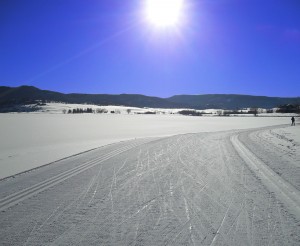
On Saturday we hit the Lake Catamount Touring Center. This is an area of groomed Nordic trails just south of Steamboat. There are several miles of skate skiing trails on Lake Catamount and the surrounding hills. By the time we got there the temps had climbed to about 20 degrees and without any wind this is very comfortable, especially for a workout. The sky was cloud free as you can see in the pic to the right. It shows a section of the groomed track. It’s pretty flat here but that’s the kind of thing you want for skate skiing. It gets much more difficult when you add in the hilly sections. This part of the track is on the lake itself, there are other parts that go up the hillsides around the lake. We were out for about 2 hours, enough to get a pretty good workout but not too exhausting for what we planned for the next day.
On Sunday we drove up to Rabbit Ears Pass, a few miles southeast of town, to do some backcountry ski touring. Though it’s been a low snow year, this area is a snow magnet and had plenty of depth for some great skiing. There are several long loops you can tour through the trees and meadows on the pass. Rabbit Ears is a unique area, most of the routes are only useable in winter. In the summer this area consists of many large mosquito-infested bogs with no useable hiking trails. But in winter the bogs are frozen and covered with several, sometimes dozens of feet of snow. The US Forest Service maintains the winter routes that are marked with blue-diamonds attached to trees or on stand-alone bamboo poles. Following these diamonds, and the ski tracks in front of you, is easy on calm, blue-sky days as Sunday. But this area is notorious for heavy snow, whiteouts and wind that can quickly erase the tracks on the snow in front of you. It’s easy to get off route in a whiteout if you aren’t paying attention to the blue diamonds
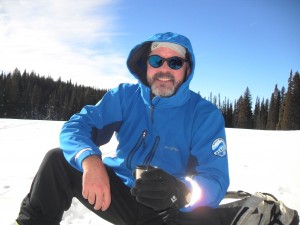 . That wasn’t a problem last weekend though as you can see from the pics of Shelly in front of aspen above and myself on the right resting with a hot drink. I was testing out a new jacket. It worked very well. There was a bit of breeze coming from my right but I was very comfortable without a heavier jacket.
. That wasn’t a problem last weekend though as you can see from the pics of Shelly in front of aspen above and myself on the right resting with a hot drink. I was testing out a new jacket. It worked very well. There was a bit of breeze coming from my right but I was very comfortable without a heavier jacket.
The route we took had the impressively imaginative name West Summit Loop A. I’ll go into further detail in a later post using a Guide category in the blog. I’m planning on adding a bunch of Steamboat area ski guides on this blog as I haven’t found a good summary anywhere. It might turn into a new guide book, who knows?
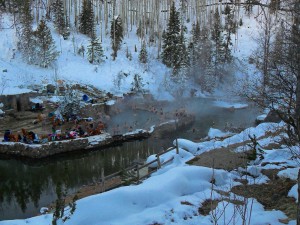 We spent about three hours on the pass. We got some turns in on a couple of slopes. That’s Shelly at the top of this post on the last long slope. The snow there was somewhat crusty and difficult to turn, but overall this was the only complaint. Rabbit Ears is in far better condition now than anything on the Front Range.
We spent about three hours on the pass. We got some turns in on a couple of slopes. That’s Shelly at the top of this post on the last long slope. The snow there was somewhat crusty and difficult to turn, but overall this was the only complaint. Rabbit Ears is in far better condition now than anything on the Front Range.
No trip to Steamboat is complete without a visit to Strawberry Hot Springs (left). Hanging out in the steaming water while surrounded by snow in minus 5 degree air is something everyone should experience. This is a natural hot spring just north of Steamboat that bubbles out at 150 degrees. The resort built up some channels to capture this water and mix it with frigid water coming down Mad Creek in several big pools that keeps the temperature at a comfortable temperature just over 100 degrees. It costs $10 per person but well worth the price to soak away your muscle soreness.
And of course at the end of it all you need refreshments! We went to a relatively new restaurant and bar called The Laundry, a great little bar on the edge of town. A good place to meet all kinds of people from artists to society dropouts (seated on either side of us that night).

Posted in Trip Reports by Mark with comments disabled.
Journal
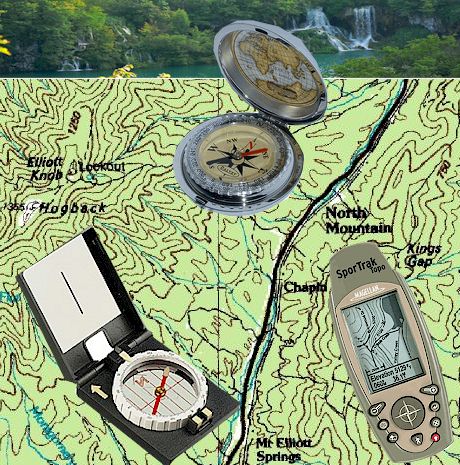
Here is a tragic but not uncommon story about getting lost in the wilderness. A father and two sons died of hypothermia after becoming lost and getting caught in a cold rainstorm in the Ozarks. Without knowing the details it is only speculation as to what happened there, but this incident appears to have a lot in common with mountaineering accidents I write about in Colorado 14er Disasters, namely the story about Michelle Vanek’s disappearance on Mount of the Holy Cross. In both of these cases an experienced leader made simple navigation errors, was ill prepared for contingencies and underestimated the deadly forces of nature. They ignored a chain of mistakes that finally ended in tragedy.
Well, as most of Colorado knows, last weekend was frigid. Some northern valleys saw temps approaching minus 40 degrees, a rarity in our state even in dead winter. That is cold! 72 degrees below the freezing point of water. Ice turns rock hard at that temperature and it’s basically too cold to snow. If there is any wind at all, even a breeze, your skin will freeze almost instantly. I remember experiencing this kind of cold a few times at 17,200 foot high camp on Denali, we really couldn’t do anything but hunker down in our huge, fluffy sleeping bags.
Another avalanche death near Marble. One interesting note on this article is the comment near the end on the rescue team response. It says that the Pitkin County team is not the primary response team for this area. Many of the mountains around Marble are just outside of Pitkin County, Marble is in Gunnison County. However, the winter access to the area is far easier from Pitkin County. Also, the Pitkin County team Mountain Rescue Aspen is one of the better teams around, it makes much more sense for the Aspen team to respond. Apparently there is a jurisdictional issue. Bottom line: If you have an accident in the Colorado mountains, choose your county well.
On an administrative note, if you’d like to leave a comment on an article, click the article title above and add comments in the form at the bottom of the page. Ignore the “comments are closed” status, they are not closed. There is a bug somewhere that I hope to get fixed soon.
-Mark
Posted in Journal by Mark with comments disabled.
